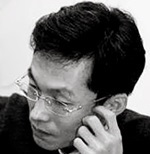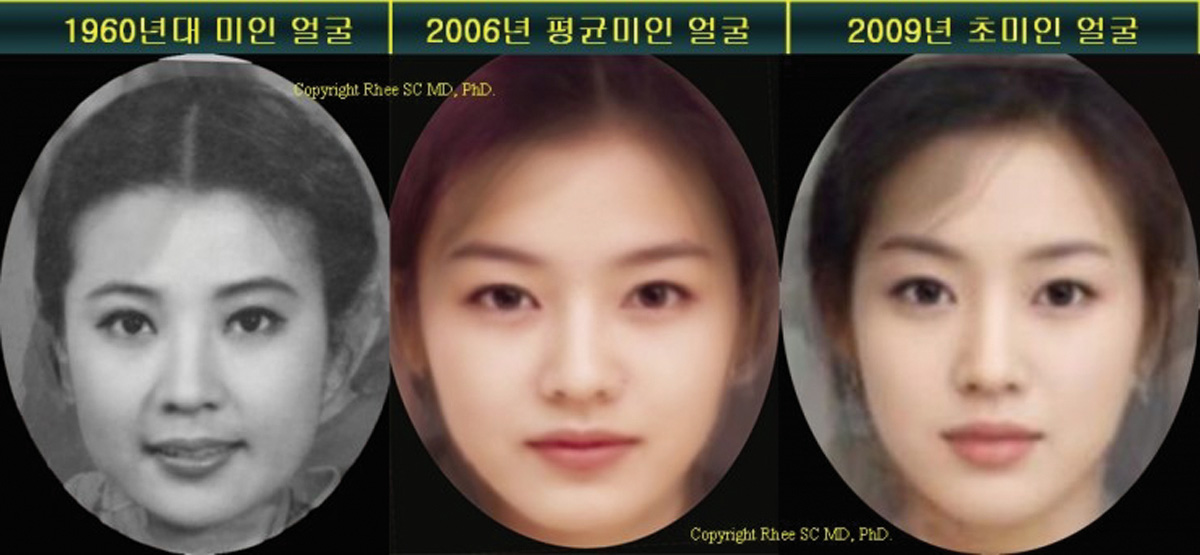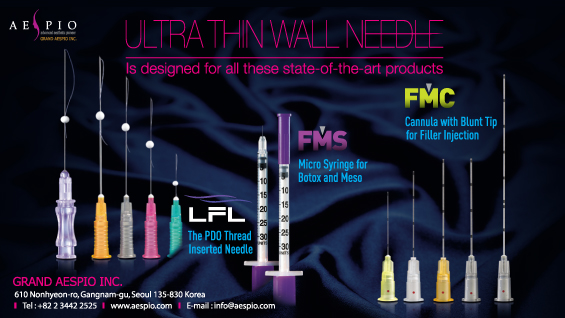
Department of plastic and Reconstructive Surgery, Ilsan Hospital
Dongguk University Medical Center, Gyeonggi-Do, Korea.
Office: http://www.dumc.or.kr/index00.jsp
Personal: http://beautyportal.co.kr
BAPA Website http://bapa.co.kr
I have tried to show how facial features of a beautiful face in Korea have been changed as time passes. The black and white image of <Figure 1> is an average composite image extracted from the four faces of Nam Jung-im, Moon Jung-hee, Moon Hee, and Yoon Jung-hee, who were the most famous actresses of the 1960s in Korea. This image contains exactly 25% of the facial features of each of the four actresses. The image in the middle is the “Average Korean Attractive Face” reported in the Aesthetic Plastic Surgery, an official journal of international society of aesthetic plastic surgeons. It is the average composite image extracted from the faces of several Korean actresses and singers (such as Kim Tae-hee, Kim Hee Sun, Park Han Byul, Son Ye Jin, Song Hye Gyo, Jeon Ji Hyun, Han Ga In, Hwang Sheen Hye, Sim Eun Ha, Lee Young Ehe, Sung Yu Ri, Son Tae Young, Song Yoon Ah, Lee Lee Hyo-ri, Chae rim, Choi Ji Woo, Kim Hyun Joo) who were thought to be beautiful around the year 2006. The average image on the right is the composite face from eight Korean actresses (such as Kim Tae-hee, Kim Hee-sun, and Park Han-byul, Son Ye Jin, Song Hye Gyo, Jeon Ji Hyun, Han Ga In, Han Ye Seul) who had most popular beautiful faces around 2009. The image contains exactly 12.5% of the face of each of the eight actresses. The three composite images are very representative of peculiar Korean beauty preference for attractive face. Most Koreans have strong preference to child-like or baby face. They all have round and large eyes and narrow lower jaws (I will discuss the specific features of a child-like face in greater detail at another topic).

Figure 1. Change in configuration of a beautiful face in time
In details, the face considered beautiful in the 1960s has chubby cheeks, a little angular lower jaws and a somewhat pentagonal facial shape. The beautiful face of the year 2006 has somewhat long and narrow face, a wide and rounded forehead, which is appeared as oval or egg shape rather than a rectangular. Besides, compared to the image of the 1960s, the image of 2006 has a longer lower face and thinner cheeks with narrower jaw lines. We can easily find that the attractive and beautiful face of the year 2009 has a kiwi-shaped outline. The attractive face of the year 2009 has brighter skin tone, narrower nasal bridge, and has lots of morphometric characteristics of a child’s face compared to the face of the year 2006. In addition, the horizontal length of the eyes (width of palpebral fissure) and the size of cheek bones have decreased, whereas the distance between eyebrows and eyes has relatively increased. You can also find that overall shape of face in the year 2009 has changed into slender appearance. To summarize, the attractive female face of today is quite different from that of the 1960s. A contemporary beautiful female face is thought to have relatively large eyes, narrower and slender lower jaws, a narrower nose and smaller lips, and have lots of characteristics of child-like face with kiwi-shaped facial contour.
[Advertisement] ULTRA THIN WALL NEEDLE – Manufacturer: AESPIO(www.aespio.com)
As discussed here, we can see that beautiful or attractive female faces of different time periods share certain common facial features and the standards of beauty have inevitably changed throughout time generation. Also, one must remember that unique racial characteristics have continuously existed regardless of the time period or generation22.
As I remarked earlier, to the question ‘do standards of beauty exist?,’ I would like to answer that ‘when it comes to a beautiful or attractive face, the standards are never absolute but relative.’ It is impossible to find or define unchanging and absolute standards of beautiful face. We only have to acknowledge changing of beauty trends and different characteristics of beauty conception or preferences according to different races, ethnicities, gender, and time periods.
In the next article, I will discuss the thesis about <What are the characteristics of a child-like face that Koreans usually want?> <Racial difference of beauty perception>> and <Difference of facial beauty according by gender and ages>in order.
References
1. Symmetry, averageness, and feature size in the facial attractiveness of women. Baudouin JY, Tiberghien G. Acta Psychol (Amst) 117(3):313-32. 2004.
2. Attractiveness of facial averageness and symmetry in non-western cultures: in search of biologically based standards of beauty. Rhodes G, Yoshikawa S, Clark A, Lee K, McKay R, Akamatsu S. Perception. 30(5):611-25. 2001.
3. "Beauty lies in the eye of the beholder"? Aspects of beauty and attractiveness. Borelli C, Berneburg M. J Dtsch Dermatol Ges. 8(5):326-30.2010.
4. The golden ratio in facial symmetry. Prokopakis EP, Vlastos IM, Picavet VA, Nolst Trenite G, Thomas R, Cingi C, Hellings PW. Rhinology. 51(1):18-21. 2013.
5. BeautiPHIcation™: a global approach to facial beauty.Swift A, Remington K.Clin Plast Surg. 2011.
6. Divine proportions in attractive and nonattractive faces. Pancherz H, Knapp V, Erbe C, Heiss AM. World J Orthod. 11(1):27-36. 2010.
7. An objective system for measuring facial attractiveness.Bashour M. Plast Reconstr Surg. 118(3):757-74.2006.
8. Facial beauty-establishing a universal standard. Jefferson Y. Int J Orthod Milwaukee. 15(1):9-22.2004.
9. Easy facial analysis using the facial golden mask. Kim YH. J Craniofac Surg. 18(3):643-9. 2007.
10. Marquardt's Phi mask: pitfalls of relying on fashion models and the golden ratio to describe a beautiful face. Holland E. Aesthetic Plast Surg. 32(2):200-8. 2008.
11. Evaluation of maxillary anterior teeth and their relation to the golden proportion in Malaysian population. Al-Marzok MI, Majeed KR, Ibrahim IK. BMC Oral Health. 24;13:9. 2013.
12. Facial aesthetics and the divine proportion: a comparison of surgical and non-surgical class II treatment. Shell TL, Woods MG. Aust Orthod J. 20(2):51-63. 2004.
13. The role of the golden proportion in the evaluation of facial esthetics. Rossetti A, De Menezes M, Rosati R, Ferrario VF, Sforza C. Angle Orthod. 83(5):801-8. 2013.
14. Assessment of facial golden proportions among young Japanese women. Mizumoto Y, Deguchi T Sr, Fong KW. Am J Orthod Dentofacial Orthop. 136(2):168-74. 2009.
15. Assessment of Facial Golden Proportions among North Maharashtri-an Population.Sunilkumar LN, Jadhav KS, Nazirkar G, Singh S, Nagmode PS, Ali FM.J Int Oral Health. 5(3):48-54. 2013.
16. Putative golden proportions as predictors of facial esthetics in adolescents. Kiekens RM, Kuijpers-Jagtman AM, van 't Hof MA, van 't Hof BE, Maltha JC. Am J Orthod Dentofacial Orthop. 134(4):480-3. 2008.
17. Averageness or symmetry: which is more important for facial attractiveness? Komori M, Kawamura S, Ishihara S. Acta Psychol (Amst). 131(2):136-42. 2009.
18. Dissociating averageness and attractiveness: attractive faces are not always average. DeBruine LM, Jones BC, Unger L, Little AC, Feinberg DR. J Exp Psychol Hum Percept Perform. 33(6):1420-30. 2007.
19. Asymmetry and human facial attractiveness: symmetry may not always be beautiful. Swaddle JP, Cuthill IC. Proc Biol Sci. 22;261(1360):111-6. 1995.
20. Computational models of facial attractiveness judgments. Bronstad PM, Langlois JH, Russell R. Perception. 37(1):126-42. 2008.
21. Why are mixed-race people perceived as more attractive? Lewis MB. Perception. 39(1):136-8. 2010.
22. Standards of facial esthetics: an anthropometric study. Jagadish Chandra H, Ravi MS, Sharma SM, Rajendra Prasad B. J Maxillofac Oral Surg. 11(4):384-9. 2012.
-To be continued-




















